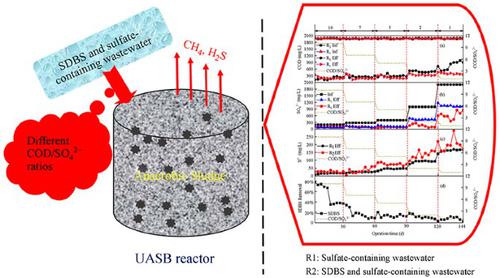Frontiers of Environmental Science & Engineering ( IF 6.1 ) Pub Date : 2020-12-18 , DOI: 10.1007/s11783-020-1385-z Ruijie Li , Mengmeng Zhou , Shilong He , Tingting Pan , Jing Liu , Jiabao Zhu

|
In this study, the effects of organic sulfur on anaerobic biological processes were investigated by operating two up-flow anaerobic sludge blanket (UASB) reactors with sodium dodecylbenzene sulfonate (SDBS) as a representative of organic sulfur. The results indicated that the specific methanogenic activity (SMA) and chemical oxygen demand (COD) removal efficiency of R2 (with SDBS added) were higher than those of R1 (without SDBS) when the COD/SO42− ratio was above 5.0. However, when the COD/SO42− ratio was lower than 5.0, the sulfate reduction efficiency of R2 was higher than that of R1. These results and the observed SDBS transformation efficiency in anaerobic reactors indicate that low concentrations of SDBS accelerate methane production and the continuous accumulation of SDBS does not weaken the reduction of sulfate. Similarly, the calculated electron flux for a COD/SO42− ratio of 1.0 indicates that the utilization intensity of electrons by sulfate-reducing bacteria (SRB) in R2 was 36.48% higher than that of SRB in R1 and exceeded that of methane-producing archaea (MPA) under identical working conditions. Moreover, the addition of SDBS in R2 made sulfidogenesis the dominant reaction at low COD/SO42−, and Methanobacterium and Methanobrevibacter with H2/CO2 as the substrate and Desulfomicrobium were the dominant MPA and SRB, respectively. However, methanogenesis was still the dominant reaction in R1, and Methanosaeta with acetic acid as the substrate and Desulfovibrio were the dominant MPA and SRB, respectively.
中文翻译:

解读十二烷基苯磺酸钠对上流厌氧污泥床层处理含硫酸盐合成废水的作用
在这项研究中,通过运行两个以十二烷基苯磺酸钠(SDBS)为代表的上流厌氧污泥床(UASB)反应器,研究了有机硫对厌氧生物过程的影响。该结果表明,甲烷生成活性(SMA)和R2的化学需氧量(COD)的去除效率(与SDBS加入)比R1(无SDBS)较高,当COD / SO 4 2 -之比为5.0以上。但是,当COD / SO 4 2−比率小于5.0时,R 2的硫酸盐还原效率高于R 1。这些结果和在厌氧反应器中观察到的SDBS转化效率表明,低浓度的SDBS会加速甲烷的产生,并且SDBS的连续积累不会削弱硫酸盐的还原。同样,计算出的COD / SO 4 2-比率为1.0的电子通量表明,R2中的硫酸盐还原细菌(SRB)对电子的利用强度比R1中的SRB高36.48%,并超过了甲烷。在相同的工作条件下生产古细菌(MPA)。此外,在R2中添加SDBS使硫化物生成成为低COD / SO 4 2-和甲烷菌的主要反应。和甲烷短用H 2 / CO 2作为底物和Desulfomicrobium分别占主导地位的MPA和SRB。然而,产甲烷仍然是R1的主要反应,以乙酸为底物的甲烷甲烷藻和脱硫弧菌分别是主要的MPA和SRB。











































 京公网安备 11010802027423号
京公网安备 11010802027423号